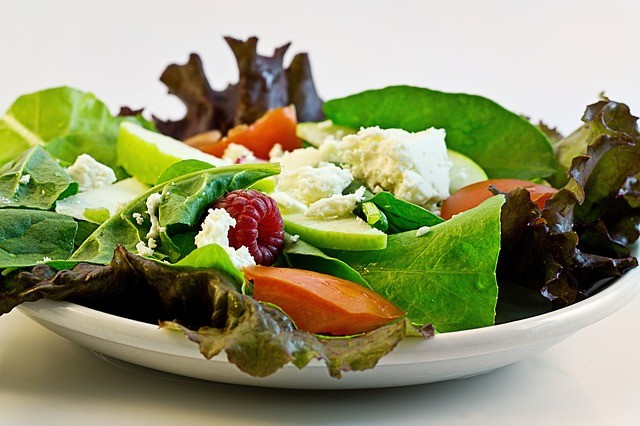
Contents
How to prepare a perfectly balanced salad?
With the beautiful days, the desires of salads flock! Simple and fast to prepare, salads are a cheap and gourmet way to prepare a balanced meal quickly. But precisely, how to compose a complete salad? What are the essential ingredients of a perfectly balanced salad? Healthzigzag.com explains all the basics to prepare a balanced meal just with a salad!
What is a balanced salad?
A salad that is ideal nutritionally is a salad that is called “complete” that is to say that contains all the nutrients essential to the functioning of our body: carbohydrates, lipids, proteins, fiber and vitamins and varied minerals to meet all the needs of the body.
Read Also: Six Essential Nutrients Which Are Important For Your Body
What are the components of a perfectly balanced salad?
# 1 The basis of a balanced salad: raw vegetables
The basis of a mixed salad is vegetables / raw vegetables. We do not skimp on quantities!
We will choose seasonal vegetables preferably and we will not hesitate to be generous because vegetables are rich in fiber, various nutrients and low in calories. They are low in calories while remaining nutritious which makes them excellent even when you pay attention to their weight.
Some ideas of vegetables to put in your salad: tomatoes, carrots, arugula, peppers, radish, cucumber, Chinese cabbage, avocado …
The tip of Healthzigzag.com: Think about fruits! The fruits can bring a touch of freshness and exoticism to your salad. They will please especially those who like sweet/salty dishes.
Some ideas of fruits to put in your salad: mango, pineapple, apple, pear, citrus, grapes, figs, strawberries … ensuring seasonality forever!
Read Also: 50 Foods That Are Super Healthy
# 2: A little starchy … for energy
The second component of a perfectly balanced salad: starchy foods. Their presence is important because they are rich in complex carbohydrates that provide energy over time. The absence of starchy foods in a salad may explain a possible bar stroke a few hours after the meal [1].
What amounts of starchy foods to add to a mixed salad? The quantities will depend on your appetite but it will always be ensured that starchy foods are present in smaller quantities than vegetables to avoid a meal too heavy to digest. Avoid accumulating starchy foods, especially by choosing several starchy foods in your salad or as an accompaniment (example: bread + pasta).
In all cases, choose starchy foods (whole wheat bread, whole-wheat pasta, etc.) that are richer in fiber and therefore more satisfying. They also have the advantage of having a low glycemic index and therefore avoid cravings very quickly after the meal.
Some starchy ideas: wholegrain rice, bulgur, buckwheat seeds, wholemeal pasta, wholemeal bread or cereals, diced toast, potato, sweet potato, lentils, kidney beans, beans …
# 3 Protein … animal or vegetable
Whether animal or plant proteins, proteins are essential to our body because they are the constituents of our muscles, but also the cells of our body in general. We will not forget to add them to a perfectly balanced salad.
Some ideas of animal proteins: ham, canned tuna, egg, chicken, salmon …
Some vegetable protein ideas: lentils, kidney beans, chickpeas, soy steak, quinoa, tofu …
Read Also: 10 Most Protein-Rich Vegetables
# 4 A source of calcium
Another component of a perfectly balanced salad mix: a source of calcium. It can be a portion of cheese (25 to 30 grams) or oilseeds, for those who do not consume dairy products.
In this case, I particularly recommend almonds, which are among the oilseeds richest in calcium. You can taper them to bring crispness to your salad or simply sprinkle them whole on your salad.
# 5 Fat (sparingly)
Finally, the last of our salad, and also in the least important quantity: the fat.
They also provide nutrients that are important in our diet, but they are caloric, so we will take care of their quantities.
In terms of fat selection, one tip: vary! We tend to focus too much on olive oil – which is a mistake. I recommend you vary the oils, giving preference to rapeseed oil, walnut oil or linseed oil, which are excellent in salads but above all that is rich in omega 3 fatty acids which we lack in our diet and which is absent in olive oil!
# 6: The bonus: herbs and spices instead of salt!
To top off a well-balanced salad, you’ll end up with a delicious seasoning. We will try to limit the use of salt, already too much in our diet, and we will make room for herbs, spices or condiments to bring a little variety on the plate and enjoy their wonderful benefits!
Herbal ideas: parsley, chives, basil, dill, fresh coriander …
Spice ideas: curry (example: curry vinaigrette sauce), turmeric, ground coriander …
Some ideas of condiments: pickles, capers, peppers, dried tomatoes, pickled garlic, fresh garlic, shallot, onions, mustard…
Read Also: Amazing health benefits of eating purple onion
Read Also: Health Benefits Of White Onion
And if we have a little hollow, we take what for dessert?
If you have a little hollow at the end of the meal, you can opt for a dessert. The ideal is obviously to choose a fruit, so fill the fiber and finish on something that will complement the meal.
If you opt for a sweet product (for example a cake for example), we can anticipate by decreasing the amounts of starch in the salad. We can also opt to completely remove them especially if you take a dessert that already contains starchy foods (for example rice pudding, semolina cake, etc.).
It is also possible to finish the meal with yogurt or cheese, in this case, no need to add calcium sources in your salad.




